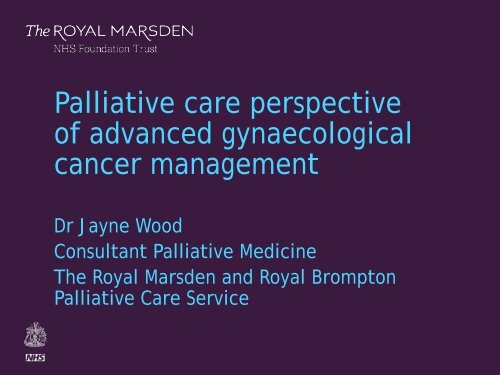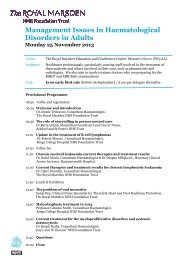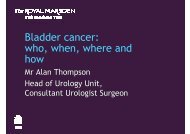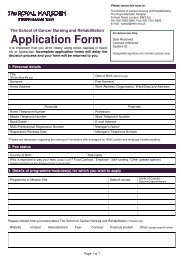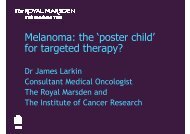Download presentation (PDF) - Royal Marsden Hospital
Download presentation (PDF) - Royal Marsden Hospital
Download presentation (PDF) - Royal Marsden Hospital
You also want an ePaper? Increase the reach of your titles
YUMPU automatically turns print PDFs into web optimized ePapers that Google loves.
The <strong>Royal</strong> <strong>Marsden</strong><br />
Palliative care perspective<br />
of advanced gynaecological<br />
cancer management<br />
Dr Jayne Wood<br />
Consultant Palliative Medicine<br />
The <strong>Royal</strong> <strong>Marsden</strong> and <strong>Royal</strong> Brompton<br />
Palliative Care Service<br />
1
2<br />
The <strong>Royal</strong> <strong>Marsden</strong><br />
Objectives<br />
– Bowel obstruction<br />
– Nausea and Vomiting<br />
– Ascites
3<br />
The <strong>Royal</strong> <strong>Marsden</strong><br />
Bowel Obstruction
4<br />
The <strong>Royal</strong> <strong>Marsden</strong><br />
Malignant Bowel Obstruction<br />
– 3% all cancers<br />
– Autopsy studies of patients with ovarian cancer:<br />
– Large and small bowel involvement in 49% and 42%<br />
cases resp. (Rose et al,1978)<br />
– Large and small bowel involvement in 78% and 70%<br />
cases, with bowel obstruction in 51% cases (Dvoretsky<br />
et al,1988)
5<br />
The <strong>Royal</strong> <strong>Marsden</strong><br />
Pathophysiology<br />
Accumulation of secretions<br />
Distension<br />
Secretion of fluid<br />
Raised intraluminal pressure<br />
Obstruction of venous drainage<br />
Reduced oxygen consumption<br />
Intestinal gangrene<br />
Perforation
6<br />
The <strong>Royal</strong> <strong>Marsden</strong><br />
Therapeutic approaches<br />
– Surgery<br />
– Stents<br />
– Decompressive techniques<br />
– Chemotherapy<br />
– Pharmacological treatments<br />
– Pain<br />
– Nausea/vomiting<br />
– Constipation<br />
– Feeding
7<br />
The <strong>Royal</strong> <strong>Marsden</strong><br />
Surgery<br />
– Published data 1989-1997 (OTPM, 2004)<br />
– Operative mortality 9-40%<br />
– Complication rate 9-90%<br />
– Survival influenced by post-operative<br />
chemotherapy<br />
– Urch et al (2002)<br />
– Prospective study<br />
– No statistical difference in median survival for<br />
patients receiving surgery or medical treatments
8<br />
The <strong>Royal</strong> <strong>Marsden</strong><br />
Decompressive techniques<br />
– Nasogastric tube<br />
– 12-29% resolution symptoms but 32-45%<br />
symptoms recur (Butler 1991)<br />
– Complications<br />
– Gastrostomy tube<br />
– Consider if symptoms failing to settle with medical<br />
management and surgery inappropriate<br />
(Campagnutta et al 1996)<br />
– Caecostomy tube
9<br />
The <strong>Royal</strong> <strong>Marsden</strong><br />
Pharmacological treatments<br />
– Pain<br />
– Opioids<br />
– Anti-spasmodic drugs<br />
– Nausea and vomiting<br />
– Antiemetics<br />
– Anticholinergics<br />
– Steroids<br />
– Somatostatin analogues<br />
– Constipation
10<br />
The <strong>Royal</strong> <strong>Marsden</strong><br />
Steroids<br />
– Feuer DJ, Broadley KE (2000)<br />
– Trend for evidence that steroids may bring about<br />
resolution (NNT=6)<br />
– Low incidence of side effects<br />
– No effect on survival<br />
– May palliate symptoms well<br />
– Length of trial period unknown (suggest 5d)
11<br />
The <strong>Royal</strong> <strong>Marsden</strong><br />
Octreotide vs Hyoscine Butylbromide<br />
– Mystakidou et al (2002)<br />
– 68 patients with inoperable bowel obstruction<br />
– Randomised to receive hyoscine butylbromide or<br />
octreotide<br />
– Significant improvement in octreotide arm with<br />
respect to:<br />
– Nausea<br />
– Vomiting<br />
– Fatigue<br />
– Anorexia<br />
– No difference in relation to pain<br />
– BUT low doses of hyoscine butylbromide used
12<br />
The <strong>Royal</strong> <strong>Marsden</strong><br />
Feeding<br />
– Parenteral nutrition<br />
– Should not be routine (Ripamonti et al, 2002)<br />
– Most will absorb sufficient fluid from gut to prevent<br />
thirst<br />
– Consider alternative management to iv fluids if<br />
thirst present<br />
– Indicated if:<br />
– Surgery being considered<br />
– Starvation likely to be cause of death
13<br />
The <strong>Royal</strong> <strong>Marsden</strong><br />
Impact of Malignant Bowel Obstruction<br />
– Gwilliam et al (2001)<br />
– Inability to eat:<br />
– Social and emotional loss<br />
– Inadequacy and displacement<br />
– Social disengagement<br />
– Disruption of identity<br />
– Alteration in activity<br />
– Deterioration of mental ability
14<br />
The <strong>Royal</strong> <strong>Marsden</strong><br />
Nausea & Vomiting
15<br />
The <strong>Royal</strong> <strong>Marsden</strong><br />
Incidence<br />
– Advanced Cancer<br />
– 60% report nausea<br />
– 30% report vomiting<br />
– Nausea and vomiting<br />
– Impairs QOL<br />
– Distressing<br />
– Aggravates cancer-related symptoms
16<br />
The <strong>Royal</strong> <strong>Marsden</strong><br />
Definitions<br />
– Nausea<br />
– “feeling of need to vomit, often accompanied<br />
by autonomic symptoms<br />
– Retching<br />
– “rhythmic, laboured, spasmodic movement of<br />
diaphragm and abdominal muscles”<br />
– Vomiting<br />
– “forceful expulsion of gastric contents<br />
through mouth”
17<br />
The <strong>Royal</strong> <strong>Marsden</strong><br />
Physiology<br />
Central stimulation:<br />
CTZ<br />
Cerebral cortex<br />
Vestibular apparatus<br />
Visual cortex<br />
Peripheral stimulation:<br />
Gut<br />
Pharynx<br />
Vomiting Centre<br />
Gastric atony<br />
Retroperistalsis<br />
Abdominal contraction
18<br />
The <strong>Royal</strong> <strong>Marsden</strong><br />
Causes<br />
Brain metastasis<br />
Raised ICP<br />
Anticipatory<br />
Emotional/psychological/<br />
spiritual<br />
Metabolic disturbance:<br />
Uraemia<br />
Electrolyte disturbance<br />
Hormone imbalance<br />
Oral thrush<br />
Cough<br />
Treatment related:<br />
Chemotherapy<br />
Radiotherapy<br />
Opioids<br />
Antibiotics<br />
Gastric stasis<br />
Constipation<br />
Bowel<br />
obstruction
19<br />
The <strong>Royal</strong> <strong>Marsden</strong><br />
Management<br />
– Identify underlying cause<br />
– Note contents<br />
– Timing<br />
– Discontinue drugs with emetic side effects<br />
– Examine patient<br />
– Mouth<br />
– Pharynx<br />
– Abdomen<br />
– Neurological systems<br />
– Blood tests<br />
– Imaging
20<br />
The <strong>Royal</strong> <strong>Marsden</strong><br />
Management<br />
– Treat<br />
– Non-drug<br />
– Acupuncture<br />
– Calm atmosphere<br />
– Small snacks<br />
– Bland foods<br />
– Drugs<br />
– Most potent<br />
– Regular administration<br />
– Appropriate route<br />
– Titrate adequately
21<br />
The <strong>Royal</strong> <strong>Marsden</strong><br />
Anti-emetics<br />
– Glare et al (2004)<br />
– Nausea in patients with advanced cancer<br />
– Good evidence for use of:<br />
– Metoclopramide and cancer related dypepsia<br />
– Steroids and bowel obstruction<br />
– LITTLE ELSE…..
22<br />
The <strong>Royal</strong> <strong>Marsden</strong><br />
Antiemetics<br />
Prokinetics<br />
– Dopamine antagonists<br />
– Indications<br />
– Gastric stasis<br />
– Gastritis<br />
– Examples<br />
– Metoclopramide<br />
– Domperidone<br />
– Side effects<br />
– Extrapyramidal side effects<br />
– Neuroleptic malignant<br />
syndrome<br />
– Drowsiness<br />
– Restlessness<br />
Haloperidol<br />
– Paucity of evidence<br />
– Trend of evidence that<br />
effective in nausea secondary<br />
to:<br />
– Variety of cancers<br />
– Bowel obstruction<br />
– Epidural morphine<br />
– Unknown causes
23<br />
The <strong>Royal</strong> <strong>Marsden</strong><br />
Antiemetics [2]<br />
Antihistamines/anticholinergics<br />
– Indications<br />
– Mechanical bowel obstruction<br />
– Raised intracranial pressure<br />
– Motion sickness<br />
– Example<br />
– Cyclizine<br />
– Hyoscine hydrobromide<br />
Phenothiazines<br />
– Indications<br />
– Unknown cause<br />
– Chemo- and<br />
radiotherapy induced<br />
nausea and vomiting<br />
– Example<br />
– Levomepromazine<br />
– Side effects:<br />
– Sedation,<br />
lowering of<br />
seizure threshold<br />
– Subcut route = twice<br />
as potent as oral<br />
route
24<br />
The <strong>Royal</strong> <strong>Marsden</strong><br />
Antiemetics [3]<br />
5HT3 antagonists<br />
– Indications<br />
– Chemotherapy<br />
– Radiotherapy<br />
– Bowel distension<br />
– Renal failure<br />
– Examples<br />
– Granisetron<br />
– Ondansetron<br />
– Side effect of<br />
constipation<br />
Steroids<br />
– Mode of action<br />
– Reduce permeability of<br />
BBB<br />
– Deplete GABA in<br />
antiemetic neurones<br />
– Anti-inflammatory<br />
– Indications<br />
– Raised intracranial<br />
pressure<br />
– Chemotherapy<br />
– Bowel obstruction<br />
– Example<br />
– Dexamethasone
25<br />
The <strong>Royal</strong> <strong>Marsden</strong><br />
Ascites
26<br />
The <strong>Royal</strong> <strong>Marsden</strong><br />
Ascites<br />
Obstruction<br />
of lymphatic<br />
drainage<br />
Cytokine release<br />
eg. VEGF, VPF,<br />
IL-6, TNF<br />
Accumulation of fluid<br />
Activation of reninangiotensinaldosterone<br />
system
27<br />
The <strong>Royal</strong> <strong>Marsden</strong><br />
Diuretic Therapy<br />
– 1 RCT (n=68), 3 cohort studies (n=43) and 1 case<br />
report (n=2)<br />
– Diuretic use inconsistent<br />
– Weak evidence assessing efficacy<br />
– Overall success ~ 43% cases (based on 5 studies)<br />
– Interval between initiation and response poorly<br />
defined<br />
– Phase II data: response may depend upon plasma<br />
renin/aldosterone concentration
28<br />
The <strong>Royal</strong> <strong>Marsden</strong><br />
Paracentesis<br />
– Temporary relief for 90% patients (Smith et al, 2003)<br />
– Complications:<br />
– Hypovolaemia<br />
– Hypoproteinaemia<br />
– Bowel perforation<br />
– Infection<br />
– Formation of drainage nodules<br />
– Peritoneocutaneous fistulae<br />
– Pain
29<br />
The <strong>Royal</strong> <strong>Marsden</strong><br />
Cochrane Database Syst Rev. 2010 Jan<br />
20;(1):CD007794.<br />
Management of drainage for malignant ascites in gynaecological cancer. Keen, A. et al<br />
– Benefit and harms of different practices in the management of<br />
drains for malignant ascites in advanced or recurrent<br />
gynaecological cancer.<br />
– Evidence re:<br />
– How long should the drain stay in place<br />
– Should the volume of fluid drained be replaced intravenously<br />
– Should the drain be clamped to regulate the drainage of fluid<br />
– Should any particular vital observations be regularly recorded<br />
– No relevant studies were identifed<br />
– Unable to make recommendations<br />
– Large, multi-centre RCTs are required to evaluate the efficacy and<br />
safety of the management of ascitic drains when in situ and their<br />
impact on QOL.
30<br />
The <strong>Royal</strong> <strong>Marsden</strong><br />
Paracentesis [2]<br />
– Stephenson et al (2002)<br />
– Variation in practice between local hospice and hospital, in<br />
relation to:<br />
– Prior USS<br />
– Use of IV fluids<br />
– Length of time drains left in (hospital>hospice)<br />
– Length of inpatient stay (hospital hospice<br />
– Clinical guidelines drawn up:<br />
– Prior USS only if ascites not easily clinically identified or<br />
signs of bowel obstruction present<br />
– IV fluids only if patient at risk of hypovolaemia<br />
– Free drainage of 5L or for 5 hours – whichever is sooner
31<br />
The <strong>Royal</strong> <strong>Marsden</strong><br />
Paracentesis [3]<br />
– Findings:<br />
– Procedure repeated more frequently in post-guidelines<br />
group, BUT<br />
– No significant difference in mean volumes drained<br />
– No cases of symptomatic hypotension in postguidelines<br />
group<br />
– Significant reduction in:<br />
– number of prior USS<br />
– Mean time drain left in<br />
– Mean duration of patient stay<br />
– BUT are hospital patients more at risk of complications…
32<br />
The <strong>Royal</strong> <strong>Marsden</strong><br />
Indwelling peritoneal catheters
33<br />
The <strong>Royal</strong> <strong>Marsden</strong><br />
PleurX peritoneal catheters<br />
<strong>Hospital</strong> Guidelines now on intranet ....
34<br />
The <strong>Royal</strong> <strong>Marsden</strong><br />
Audit of use of PleurX peritoneal catheters:<br />
Results<br />
– N = 15<br />
– 100% technical success rate<br />
– Complications:<br />
– Leakage (14%):<br />
– amended with additional suture<br />
– The average:<br />
– Number of previous paracentesis was 3.6 (range 0<br />
– 7; median of 3).<br />
– Time between insertion and death was 23.9 days<br />
(range 8 - 46 days; median of 21 days).<br />
– No drains were removed between insertion and<br />
death.
35<br />
The <strong>Royal</strong> <strong>Marsden</strong><br />
PleurX drain in management of malignant ascites: safety, complications, longterm<br />
patency, factors predictive of success.<br />
Br J Radiol. 2012 May;85(1013):623-8. Epub 2011 Mar 22. Tapping, CR et al.<br />
– Over a 4y period<br />
– 28 consecutive patients (32 drain insertions)<br />
– 7 males and 21 females (mean age, 61 years)<br />
– 4 inserted with combination of fluoroscopic and ultrasound<br />
guidance and 28 under ultrasound guidance alone.<br />
– 100% technical success rate for the insertion of the drain<br />
– No procedure-related deaths and no major complications<br />
– Minor complications were reported<br />
– Three (10%) immediate; three (10%) early; and two (7%) late.<br />
– Factors significantly associated with complications:<br />
– chemo, low Hb, low albumin, high WBC and high c-reactive<br />
protein<br />
– Length of time the drains in situ: 5 to 365 days (mean, 113 days)<br />
– 24 (86%) in situ and functioning until the patients' death.<br />
– 4 (14%) drains dislodged but drains remained patent until the<br />
patient's death.
36<br />
The <strong>Royal</strong> <strong>Marsden</strong><br />
Multiple Choice Question 1<br />
A Cochrane review (2000) on the use of steroids in<br />
bowel obstruction showed that there was:<br />
1. No trend for evidence that steroids may bring<br />
about resolution<br />
2. Low incidence of side effects<br />
3. Negative effect on survival<br />
4. Unlikely to palliate symptoms well<br />
5. Clear evidence to suggest a length of trial period
37<br />
The <strong>Royal</strong> <strong>Marsden</strong><br />
Multiple Choice Question 2<br />
Which of the following antiemetics does not act at the<br />
D2 receptor<br />
1. Metoclopramide<br />
2. Haloperidol<br />
3. Aprepitant<br />
4. Cyclizine<br />
5. Levomepromazine
38<br />
The <strong>Royal</strong> <strong>Marsden</strong><br />
Multiple Choice Question 3<br />
Which of the following complications might be<br />
associated with paracentesis:<br />
1. Bowel perforation<br />
2. Formation of drainage nodules<br />
3. Leakage at drain site<br />
4. Peritoneocutaneous fistula<br />
5. All of above
39<br />
The <strong>Royal</strong> <strong>Marsden</strong><br />
Conclusion<br />
– Bowel obstruction<br />
– Nausea and vomiting<br />
– Ascites


